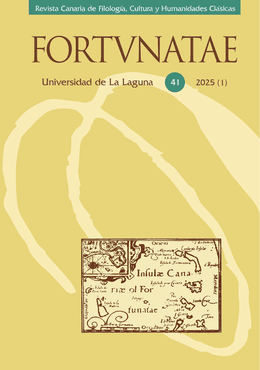CALL FOR PAPERS/PETICIÓN DE ORIGINALES Nº 43
Se abre el plazo de recepción para el número 43 (2026,1). Hasta 15 MARZO 2026.
Leer más acerca de CALL FOR PAPERS/PETICIÓN DE ORIGINALES Nº 43

Se abre el plazo de recepción para el número 43 (2026,1). Hasta 15 MARZO 2026.
Leer más Leer más acerca de CALL FOR PAPERS/PETICIÓN DE ORIGINALES Nº 43

El número se abre con el artículo de Juan Manuel Arriaga Benítez, “La Tetis que Júpiter rechazó: el cierre hesiódico de destronamientos en una écfrasis valeriana (Arg. I, 130-139)”, que parte de una de las pinturas que adornan la nave de los Argonautas en Valerio Flaco, en la que se describen brevemente las bodas de Tetis y Peleo. Este adorno ha tenido dos interpretaciones predominantes, la conquista del océano y la anticipación del matrimonio entre Medea y Jasón. No obstante, en este artículo se propone una tercera interpretación relacionada con el ciclo de alternancias por destronamiento de una deidad suprema por otra, con el cierre de este ciclo a cargo de Zeus/Júpiter como dios de poder indisputable. En “El léxico de las zonas erógenas en la Antología Palatina”, Esteban Calderón Dorda presenta un estudio sobre el léxico de las zonas erógenas en los epigramistas de la Antología Palatina, pero haciendo un especial hincapié sobre la incidencia que en ellos tiene el lenguaje popular en convivencia con términos técnicos y mostrando una maestría poética en la combinatoria de todos ellos con juegos anfibológicos o eufemísticos de alta calidad. Por su parte, Soledad Correa trata de la muerte, el drama y la ejemplaridad como los tres ejes centrales para abordar el epistolario de Séneca en “Non trepidabo ad extrema: mors, performance y ejemplaridad en Sen., Epist. 54”. La carta escogida representaría una meditatio mortis y establece el momento de la muerte como una performance decisiva para la valoración de la propia vida. Esta carta se puede leer como la puesta en escena de un ensayo de su suicidio forzado, cuyo relato posterior en Tácito (Ann. 15, 60-64) nos llevaría a interpretar una cierta coherencia con lo teorizado y un acuerdo entre oratio y vita. La “edición crítica de Pseudo-Hipócrates, De venae sectione (extracto de Galeno, De cur. rat. per venae sect.)” de Elsa García Novo recoge la edición de un pequeño tratado sobre la flebotomía atribuido mayoritariamente a Hipócrates y que recogen trece manuscritos, tratándose en realidad de un extracto de Galeno, de su De curandi ratione. El trabajo consigue establecer un stemma de los textos agrupándolos en tres familias, y en su comparación con el original de Galeno llegan a aportar algunas lecciones importantes para este. Sobre las “Inscripciones griegas en la decoración de la casa de Schliemann en Atenas” versa el artículo de Antonio Ramón Navarrete Orcera. El estudio muestra cómo en su mayoría (son un total de 48), aparte de su adecuación temática a la sala en la que están ubicadas, se caracterizan por su valor preceptivo y moral, habiendo sido extraídas de los autores griegos más importantes, de las sentencias de los siete sabios y de fragmentos conservados de la Antología Palatina, mostrando el dominio de los textos que tenía el famoso arqueólogo. Joaquín Pascual-Barea nos presenta un estudio sobre la toponimia de la localidad conquense de Noheda, argumentando su procedencia de Novata, nombre de una villa romana próxima, en la que se conservan algunos mosaicos que representan obras teatrales, y en los que aparecen referencias escénicas a un relato de Apuleyo o un resto textual que nos lleva al Anfitrión de Plauto. A la etimología está dedicado el último artículo de la serie, bajo la autoría de María Teresa Santamaría Hernández: “Etimología de ajar y del ajo perdido, y su relación con alear y lío”. El verbo español ajar (allēuare) se vincula formal y semánticamente con un sustantivo ajo, que es diferente, por su origen y significado, del nombre homógrafo y homófono que designa el vegetal usado frecuentemente como ingrediente culinario. Se revisan otras interpretaciones diferentes de ajar propuestas anteriormente. Se analizan y explican los distintos usos y acepciones en español del término ajo derivado de ajar, revelando así su conexión con la palabra lío. La diferenciación formal y semántica de ambos ajos permite aclarar algunas confusiones sostenidas en el ámbito lexicográfico a lo largo del tiempo.
Completan el número dos recensiones sobre sendas obras recientes: Guus Kroonen (ed.), Sub-Indo-European Europe, a cargo de Marcos Medrano Duque, y Francisco García Jurado, Teoría de la tradición clásica. Conceptos, historia y métodos, reseñada por Genaro Valencia Constantino.
Fortunatae es una publicación electrónica, gratuita y de libre acceso adscrita al Departamente de Filología Clásica, Francesa, Árabe y Románica de la Universidad de La Laguna. Su objetivo es la difusión de las investigaciones sobre las diferentes disciplinas relacionadas con la Filología Clásica y los estudios clásicos en general. La revista aspira no solo a llegar al público especializado en la materia sino también a cuantas personas se interesen por los ámbitos que abarca.
Acoge, desde el año de su inicio en 1991, investigaciones y estudios originales e inéditos de autores nacionales y extranjeros. La revista tiene un enfoque amplio y recibe artículos y reseñas sobre las diferentes manifestaciones literarias y los nuevos objetos de estudio que han surgido dentro del ámbito de los estudios clásicos y su pervivencia.
Este trabajo está bajo una licencia CC BY-NC-ND 4.0
